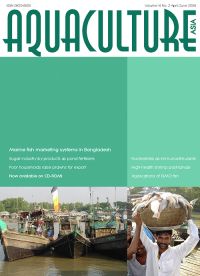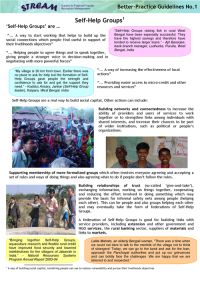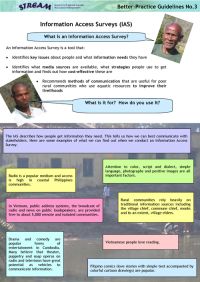In this issue:
High-health postlarvae a prerequisite for sustainability of the Indian shrimp industry. Broodstock and all-female scampi grow out ponds in south India. Genetically modified fish and potential applications. Rainbow trout farming in hill terraces of Nepal. Sugar industry by-products as plankton boosters and yield enhancers in carp culture. Growth and production of Penaeus monodon in low saline culture systems. Poor households raise prawns for export. Marine fish marketing in Bangladesh.
In this issue:
NACA Governing Council endorses new work programme, elects Sena De Silva as next Director General. RapiDot Kit - Farmer friendly kit for WSSV detection. Regional mariculture program strengthened. Economics and marketing analysis of the live reef fish food trade in the Asia-Pacific. Workshop on molecular techniques in aquaculture and seafood safety, Mangalore, India. Better-practice approaches for culture-based fisheries development in Asia. High-level Bahrain fisheries deletation visits Iran. First monthly meeting of fish farmers at One-stop Aqua Shop in Punjab Pakistan. Fish breeding training program for farmers of OAS, Kaipara. Provincial workshops on National Fisheries Policy and Strategy Framework held in Punjab and Sindh, Pakistan. Monitoring and evaluating the impacts of aquaculture on the agency and well-being of women. STREAM welcomes AYAD volunteer. Workshop to strengthen aquatic animal health capacity and biosecurity in ASEAN. Asian Federation for Information Technology in Agriculture (AFITA) 2006 in Bangalore. Aquaculture rehabilitation project launched by Indonesian Minister of Marine Affairs and Fisheries.
Our better-practice guidelines are an attempt to share lessons that are learnt from local practice or from research, with many more people within Asia-Pacific and to enable people, institutions and policy-makers to use new tools and mechanisms which support aquatic resources management in ways that benefit the livelihoods of people who are poor. This publication is also available in Bahasa Indonesia, Bengali, Hindi, Ilonggo, Khmer, Myanmar, Nepali, Oriya, Sinhala, Urdu and Vietnamese.
Self-help groups are a way to start working that helps to build up the social connections which people find useful in support of their livelihoods objectives, helping people to agree on things and to speak together, giving people a stronger voice in decision-making and in negotiating with more powerful forces. This publication is also available in Bahasa Indonesia, Bengali, Hindi, Ilonggo, Khmer, Myanmar, Nepali, Oriya, Sinhala, Urdu and Vietnamese.
An information access survey is a tool that identifies key issues about people and what information needs they have, what media sources are available, what strategies people use to get information and how cost effective they are. It also provides guidance on methods of communication that are useful for poor rural communities that use aquatic resources to improve their livelihoods. This document is also available in Bahasa Indonesia, Bengali, Hindi, Ilonggo, Khmer, Myanmar, Nepal, Oriya, Sinhala, Urdu and Vietnamese.




